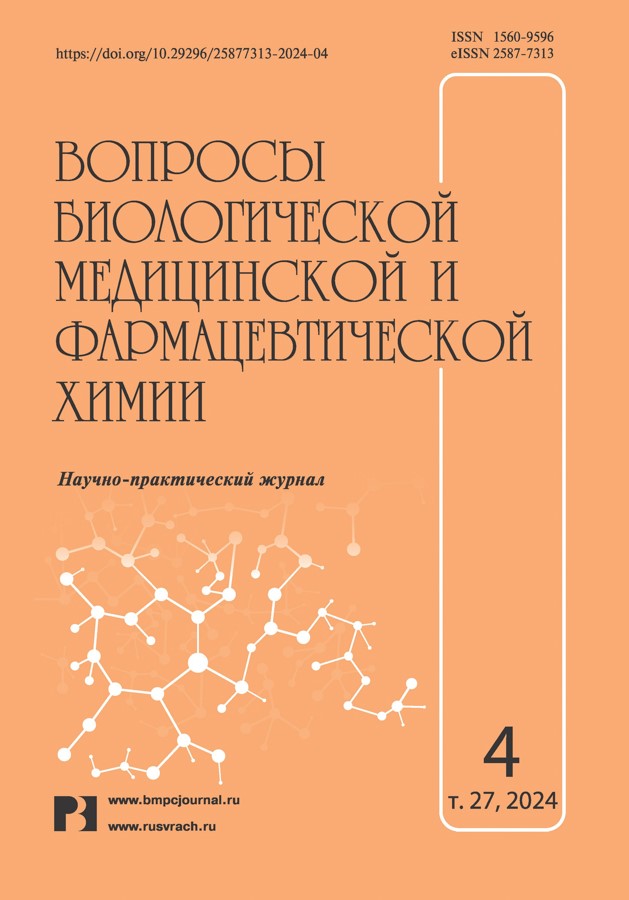Study of HIF-1α-signaling pathway components in plasma of patients with COVID-19 infection of different degrees of severity
- Authors: Raitsev S.N.1, Zvyagina V.I.1, Belskikh E.S.1, Marsyanova Y.A.1, Maksaev D.A.1, Chobanyan A.A.2
-
Affiliations:
- Ryazan State Medical University named after academician I.P. Pavlov
- City Clinical Hospital of Emergency Medical Care
- Issue: Vol 27, No 4 (2024)
- Pages: 57-62
- Section: Medical chemistry
- URL: https://journals.eco-vector.com/1560-9596/article/view/631293
- DOI: https://doi.org/10.29296/25877313-2024-04-08
- ID: 631293
Cite item
Abstract
Introduction. Recent work demonstrates that HIF-1α and NOS isoforms are detectable in plasma, representing their potential practical relevance as biomarkers. At the same time, data on the stability of these proteins in plasma are contradictory.
Aim of the study. To investigate the amount of HIF-1α and iNOS in plasma of patients with COVID-19 infection of different severity to assess the possibilities of adaptation to hypoxia.
Material and methods. The pilot study involved 50 patients divided into three groups: 1) 17 patients with moderate severity of the disease; 2) 17 patients in severe condition; 4) 16 patients with extremely severe course of the disease. The amounts of HIF-1α and iNOS were determined by competitive ELISA.
Results. Patients with extremely severe course of COVID-19 infection showed lower levels of HIF-1α and blood saturation compared to the moderate and severe course groups. The iNOS levels were significantly lower in the extremely severe course group compared to patients with moderate disease severity. When patients were evaluated according to the degree of lung damage based on CT scans, reduced HIF-1α levels were identified in the CT-3-4 group compared to the CT-0-1 (p = 0.0006) and CT-2 (p = 0.0031) groups.
Conclusions. Decreased levels of HIF-1α and iNOS in extremely critically ill patients may serve as an unfavorable prognostic marker.
Full Text
About the authors
S. N. Raitsev
Ryazan State Medical University named after academician I.P. Pavlov
Author for correspondence.
Email: raitsevsergei@yandex.ru
Post-graduate Student, Department of Biological Chemistry
Russian Federation, RyazanV. I. Zvyagina
Ryazan State Medical University named after academician I.P. Pavlov
Email: raitsevsergei@yandex.ru
Ph.D. (Biological), Associate Professor, Department of Biological Chemistry
Russian Federation, RyazanE. S. Belskikh
Ryazan State Medical University named after academician I.P. Pavlov
Email: raitsevsergei@yandex.ru
Ph.D. (Med.), Assistant of the Department of Faculty Therapy named after Prof. V.Y. Garmash
Russian Federation, RyazanY. A. Marsyanova
Ryazan State Medical University named after academician I.P. Pavlov
Email: raitsevsergei@yandex.ru
Assistant, Department of Biological Chemistry
Russian Federation, RyazanD. A. Maksaev
Ryazan State Medical University named after academician I.P. Pavlov
Email: raitsevsergei@yandex.ru
Ph.D. (Med.), Assistant of the Department of Cardiovascular, X-ray Endovascular Surgery and Radiologic Diagnostics
Russian Federation, RyazanA. A. Chobanyan
City Clinical Hospital of Emergency Medical Care
Email: raitsevsergei@yandex.ru
Ph.D. (Med.), Vascular Surgeon
Russian Federation, RyazanReferences
- Serebrovska Z.O., Chong E.Y., Serebrovska T.V. et al. Hypoxia, HIF-1α, and COVID-19: from pathogenic factors to potential therapeutic targets. Acta pharmacologica Sinica. 2020; 41(12): 1539–1546; https://doi.org/10.1038/s41401-020-00554-8
- Hirota K. Hypoxia-dependent signaling in perioperative and critical care medicine. J Anesth. 2021; 35(5): 741–756. doi: 10.1007/s00540-021-02940-w.
- Semenza G.L. HIF-1 and mechanisms of hypoxia sensing. CurrOpin Cell Biol. 2001; 13(2): 167–171. doi: 10.1016/s0955-0674(00)00194-0.
- Марсянова Ю.А., Звягина В.И. Гипоксия-подобный эффект L-аргинина в семенных пузырьках и эпидидимисе крыс. Российский медико-биологический вестник им. академика И.П. Павлова. 2023; 31(3): 345–356. doi: 10.17816/PAV-LOVJ108589 (Marsjanova Ju.A., Zvjagina V.I. Gipoksija-podobnyj jeffekt L-arginina v semennyh puzyr'kah i jepididimise krys. Rossijskij mediko-biologicheskij vestnik im. akademika I.P. Pavlova. 2023; 31(3): 345–356. doi: 10.17816/PAVLOVJ108589).
- Kaelin W.G. Jr, Ratcliffe P.J. Oxygen sensing by metazoans: the central role of the HIF hydroxylase pathway. Mol Cell. 2008; 30(4): 393–402. doi: 10.1016/j.molcel.2008.04.009.
- Wierońska J.M., Cieślik P., Kalinowski L. Nitric Oxide-Dependent Pathways as Critical Factors in the Consequences and Recovery after Brain Ischemic Hypoxia. Biomolecules. 2021; 11(8): 1097. doi: 10.3390/biom11081097.
- Калинин Р.Е., Сучков И.А., Мжаванадзе Н.Д. и др. Метаболиты оксида азота при развитии осложнений после открытых реконструктивных вмешательств у пациентов с периферическим атеросклерозом. Наука молодых (Eruditio Juvenium). 2021; 9(3): 407–414 (Калинин Р.Е., Сучков И.А., Мжаванадзе Н.Д. и др. Метаболиты оксида азота при развитии осложнений после открытых реконструктивных вмешательств у пациентов с периферическим атеросклерозом. Наука молодых (Eruditio Juvenium). 2021; 9(3): 407–414).
- Cinar R., Iyer M.R., Kunos G. Dual inhibition of CB1 receptors and iNOS, as a potential novel approach to the pharmacological management of acute and long COVID-19. British journal of pharmacology. 2022; 179(10): 2121–2127. doi: 10.1111/bph.15461.
- He J. Hu Y., Hu M., et al. The relationship between the preoperative plasma level of HIF-1α and clinic pathological features, prognosis in non-small cell lung cancer. Scientific reports. 2016; 6: 20586. doi: 10.1038/srep20586.
- Sowjanya A.P., Rao M., Vedantham H. et al. Correlation of plasma nitrite/nitrate levels and inducible nitric oxide gene expression among women with cervical abnormalities and cancer. Nitric oxide: biology and chemistry. 2016; 52: 21–28. doi: 10.1016/j.niox.2015.09.005.
- Временные методические рекомендации: Профилактика, диагностика и лечение новой коронавирусной инфекции (COVID-19), версия 10 от 08.02.2021. from: https://static-0.minzdrav.gov.ru/system/attachments/attaches/000/054/662/original/Временные_МР_COVID-19_%28v.10%29.PDF (Vremennye metodicheskie rekomendacii: Profilaktika, diagnostika i lechenie novoj koronavirusnoj infekcii (COVID-19), versija 10 ot 08.02.2021. from: https://static-0.minzdrav.gov.ru/sys-tem/attachments/attaches/000/054/662/original/Vremennye_MR_COVID-19_%28v.10%29.PDF).
- Roca O., Caralt B., Messika J. et al. An Index Combining Respiratory Rate and Oxygenation to Predict Outcome of Nasal High-Flow Therapy. American journal of respiratory and critical care medicine. 2019; 199(11): 1368–1376. doi: 10.1164/rccm.201803-0589OC.
- Gianstefani A. Farina G., Salvatore V., et al. Role of ROX index in the first assessment of COVID-19 patients in the emergency department. Internal and emergency medicine. 2021; 16(7): 1959–1965; https://doi.org/10.1007/s11739-021-02675-2.
Supplementary files






